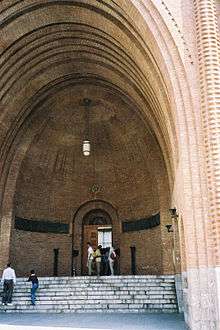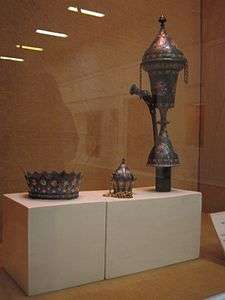National Museum of Iran
| موزهٔ ملی ایران – Muze ye Melli ye Irān | |
|
Museum of Ancient Iran | |
| Established | 1937 |
|---|---|
| Location | Tehran, Iran |
| Type | Archaeology museum |
| Collection size | Archaeological collections from Paleolithic to Qajar period |
| Director | Jebrael Nokandeh |
| Owner | ICHTO |
The National Museum of Iran (Persian: Muze ye Melli ye Irān – موزهٔ ملی ایران) is located in Tehran, Iran.
It is an institution formed of two complexes, including the Museum of Ancient Iran (Muze ye Irān e Bāstān) which was inaugurated in 1937, and the Museum of the (post-) Islamic Era (Muze ye Dowrān e (pasā) Eslāmi) which was inaugurated in 1972.
It hosts historical monuments dating back through preserved ancient and medieval Iranian antiquities, including pottery vessels, metal objects, textile remains, and some rare books and coins.[1]
There are a number of research departments in the museum, including Paleolithic and Osteological departments, and a center for Pottery Studies.
History

The brick building of the Museum of Ancient Iran was designed by the French architect Andre Godard in the early 20th century. It was influenced by Sassanid vaults, particularly the Eyvān-e-Kasrā at Ctesiphon. With an area of approximately 11000 square meters, its construction began in 1935 and was completed within two years by Abbas Ali Memar and Morad Tabrizi. The complex was officially inaugurated in 1937.
The later constructed Museum of the (post-) Islamic Era was built with white travertine on the grassy grounds of the Museum of Ancient Iran. It has gone through quite a few hasty interior changes, and was still being remodeled when the 1979 Revolution swept the country.
While the Museum of Ancient Iran always had a clear mandate to show archaeological relics, as well as some rare medieval textiles and rug pieces, the newer building began to also feature the exquisite Amlash pottery from the prehistoric Caspian Sea regions of Iran. This was followed by some modern arts, and the repeated gutting and remodeling of the interior.
The older building consists of three halls. The halls contain artifacts and fossils from the lower, middle, and upper Paleolithic, as well as the Neolithic, Chalcolithic, early and late Bronze Age, and Iron Ages I-III, through the Median, Achaemenid, Seleucid, Parthian, and Sassanid periods.
The Museum of the (post-) Islamic Era consists of three floors. It contains various pieces of pottery, textiles, texts, artworks, astrolabes, and adobe calligraphy, from Iran's post-Islamic era.
Plans are underway for the construction of another building, as the current ones lack the capacity and standards for preserving all of the excavated treasures. The collection amounts to 300,000 artifacts.[2]
Collections
The oldest artifacts in the museum are from Kashafrud, Darband and Ganj Par, sites that date back to the Lower Paleolithic period. Mousterian stone tools made by Neanderthals are also on display in the first hall of the Museum of Ancient Iran. The most important Upper Paleolithic tools are from the Yafteh Cave, dating back about 30,000-35,000 years. There are also 9,000 year-old human and animal figurines from Sarab Hill in Kermanshah Province, among many other ancient artifacts.
Departments
- Conservation Department
- Paleolithic Department
- Osteological Department
- Prehistoric Department
- Historic Department
- Islamic Department
- Inscriptions Department
- Seals and Coins Department
- Center for Pottery Studies
Exhibitions
The ground floor of the newer building is dedicated to contemporary exhibitions of the museum's collections. The temporary exhibition galleries are featured two or three times annually, and they are usually run for about one to two months. One of the most successful exhibitions, titled Evidence for Two Hundred Thousand Years of Human-Animal Bonds in Iran, ran from August to October 2014.[3] The exhibition was mainly about the relation and coexistence of past human societies and various animal species in Iran, since the late Lower Paleolithic to the modern-day decades.
Gallery
 Side view of the Museum of Ancient Iran
Side view of the Museum of Ancient Iran.jpg) Inside the section of paintings,
Inside the section of paintings,
Museum of the (post-) Islamic Era Marlik Cup
Marlik Cup- Statue of the Parthian Noble Man, Museum of Ancient Iran
 A hookah from 19th century, Museum of the (post-) Islamic Era
A hookah from 19th century, Museum of the (post-) Islamic Era Statue of a mastiff, found in the Apadana at Persepolis, Museum of Ancient Iran
Statue of a mastiff, found in the Apadana at Persepolis, Museum of Ancient Iran- Statue of Darius I, Museum of Ancient Iran
- An Elamite statue of a bull, from the late 2nd millennium BC
See also
- Saltmen
- Iranian Crown Jewels
- Tehran Museum of Contemporary Art (website)
- Iran's National Rug Gallery
- Iran Cultural Heritage Organization
- Azarbaijan Museum
- International rankings of Iran
- Malek National Library
- Surena
- Reza Abbasi Museum
- List of museums in Iran
- Safir Office Machines Museum
References
External links
| Wikimedia Commons has media related to National Museum of Iran. |
- Photo Gallery of the National Museum of Iran
- National Museum of Iran
- National Museum of Iran
- Sa'd Abad Gallery of Fine Arts
- Glassware Museum of Tehran
- Hamid-Reza Hosseini, Shush at the foot of Louvre (Shush dar dāman-e Louvre), in Persian, Jadid Online, 10 March 2009, .
Audio slideshow: (6 min 31 sec).
Coordinates: 35°41′13.36″N 51°24′52.60″E / 35.6870444°N 51.4146111°E
